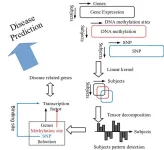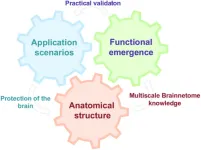(Press-News.org) PHILADELPHIA – Women and those from racial and ethnic groups underrepresented in medicine (URiM) not only occupy few leadership roles in surgical departments but also tend to be clustered into certain leadership roles, according to a new analysis led by researchers from the Perelman School of Medicine at the University of Pennsylvania. These clusters of roles include vice chairs of diversity, equity, and inclusion (DEI) or wellness, where the promotion path to department chair is unclear. The report was published today in JAMA Surgery and led by Oluwadamilola “Lola” Fayanju, MD, MA, MPHS, the Helen O. Dickens Presidential Associate Professor and chief of the Breast Surgery Division, who joined Penn in 2021 and has since become the first Black division chief in the history of Penn’s department of Surgery.
The field of surgery has long been dominated by white men, who account for nearly half (46.2 percent) of practicing general surgeons, according to the Association of American Medical Colleges (AAMC). While recruiting a diverse pipeline of physicians has become a priority in recent decades, whether these efforts will translate into diversity at leadership levels will take time to realize. Currently, women represent 14.1 percent of surgery department chairs, and represent only 8.9 percent of surgery department leaders at academic medical centers in the United States.
“A longtime metric for success of diversity in medicine is how many women and people from certain backgrounds are department chairs, which represents the pinnacle of achievement in academic medicine,” Fayanju said. “For this study, we wanted to look at multiple levels of leadership, a proxy for trajectory through leadership, across all surgical specialties and ask whether the field is looking at the right pipelines and endpoints to achieve a level of diversity in physician leadership that better mirrors the diversity of our patient population in the U.S.”
The study included data from publicly accessible websites of 165 departments of surgery, neurosurgery, obstetrics and gynecology (OBGYN), ophthalmology, orthopedics, and otolaryngology in medical schools and affiliated hospitals in the U.S. and Puerto Rico. The researchers used methodology previously developed and used in other published studies to identify demographics of more than 2,000 surgery leaders based on the publicly available profile, biography, and visual information found online. To overcome and address the limitations of this approach, the team used a multi-coder system with a diverse team of reviewers.
In academic medicine – where medical schools are associated with hospitals that provide patient care – department chairs are physicians or researchers who also have an administrative role to lead a large group of faculty members with the same expertise, such as surgery or medicine. They may be supported by a leadership team that includes vice chairs, who generally do not have direct reports, and division chiefs, who function in roles similar to the chair, in that they oversee staff, budgets, and programs, for a smaller, further specialized group of faculty members, such as cardiovascular surgery or hematology-oncology. In recent years, with greater attention on racial justice and work-life balance, additional vice chair roles that support newly prioritized focus areas, such as DEI or faculty development, have become more common.
Fayanju and colleagues found that women were more likely to be in a surgery vice chair role (31.6 percent female vs. 68.4 percent male) than in a surgery chair (14.1 percent female vs. 85.9 percent male) or division chief role (12.9 percent female vs. 87.1 percent male). Even in OBGYN, where most physicians are women, they only account for 32.9 percent of department chairs. Vice chairs of DEI were majority female (64.5 percent) and URiM individuals (51.6 percent), while vice chairs of faculty development were split evenly between men and women, with only 17.9 percent URiM individuals. Breast/Endocrine surgery was the only specialty where women held the majority (63.6 percent) of division chief roles. No URiM individuals held vice chair of research roles.
The demographics of surgery division chiefs most closely resembled the current demographics of surgery department chairs, but women and those from underrepresented backgrounds were less likely to be in these roles. The authors note that it’s unclear if this is a lag effect of recruitment efforts and newly created leadership roles or if women and URiM individuals are being elevated to leadership roles that don’t necessarily have a path for promotion to chair.
The authors suggest the findings should also prompt academic medicine leaders to rethink traditional paths and metrics for promotion, such as grant funding, publications, and other measurements that may not relate to leadership ability.
“We know that other fields are looking at how to promote people and recognize their excellence without appointing them to lead others simply because it’s the next step,” Fayanju said. “We should think about how different opportunities for career advancement can be promoted and we should also equip diverse people for leadership, so that everyone has the opportunity to put themselves forward for leadership roles that align with their interests and career goals.”
The co-first authors were Yoshiko Iwai, MS, of The University of North Carolina at Chapel Hill School of Medicine, and Alice Yunzi L. Yu, MD, of the Northwestern University Feinberg School of Medicine. The work was supported by the National Institutes of Health (7K08CA241390, P30CA014236), the Duke Cancer Institute, and the Duke Global Health Institute.
###
Penn Medicine is one of the world’s leading academic medical centers, dedicated to the related missions of medical education, biomedical research, excellence in patient care, and community service. The organization consists of the University of Pennsylvania Health System and Penn’s Raymond and Ruth Perelman School of Medicine, founded in 1765 as the nation’s first medical school.
The Perelman School of Medicine is consistently among the nation's top recipients of funding from the National Institutes of Health, with $550 million awarded in the 2022 fiscal year. Home to a proud history of “firsts” in medicine, Penn Medicine teams have pioneered discoveries and innovations that have shaped modern medicine, including recent breakthroughs such as CAR T cell therapy for cancer and the mRNA technology used in COVID-19 vaccines.
The University of Pennsylvania Health System’s patient care facilities stretch from the Susquehanna River in Pennsylvania to the New Jersey shore. These include the Hospital of the University of Pennsylvania, Penn Presbyterian Medical Center, Chester County Hospital, Lancaster General Health, Penn Medicine Princeton Health, and Pennsylvania Hospital—the nation’s first hospital, founded in 1751. Additional facilities and enterprises include Good Shepherd Penn Partners, Penn Medicine at Home, Lancaster Behavioral Health Hospital, and Princeton House Behavioral Health, among others.
Penn Medicine is an $11.1 billion enterprise powered by more than 49,000 talented faculty and staff.
END
At a glance:
New AI tool called EVEscape uses evolutionary and biological information to predict how a virus could change to escape the immune system.
The tool successfully predicted the most concerning new variants that occurred during the COVID-19 pandemic.
Researchers say the tool can help inform the development of vaccines and therapies for SARS-CoV-2 and other rapidly mutating viruses.
The COVID-19 pandemic seemed like a never-ending parade of SARS-CoV-2 variants, each equipped with new ways to evade the immune system, leaving the world bracing for what would come next.
But what if there were a way to make predictions ...
Imagine researchers exploring a dark room with a flashlight, only able to clearly identify what falls within that single beam. When it comes to microbial communities, scientists have historically been unable to see beyond the beam — worse, they didn’t even know how big the room is.
A new study published online October 11, 2023 in Nature highlights the vast array of functional diversity of microbes through a novel approach to better understand microbial communities by looking at protein function within them. The work was led by a team of scientists at the U.S. Department of Energy ...
【Research Study】
1. Background
Multiomics3 analysis that integrates different layers of profiles altogether is challenging, since the number of variables in profile substantially differ from each other. For instance, gene expression profile and genomic DNA methylation profile are often analyzed together, however, there are only tens of thousands of genes, whereas the number of DNA methylation sites are as many as tens of millions. The numbers differ one thousand times and the number ...
University of Virginia School of Medicine researchers have obtained new insights into how African-American and Hispanic-American people’s genes influence their ability to use Omega-3 and Omega-6 fatty acids for good health. The findings are an important step toward “precision nutrition” – where a diet tailored to exactly what our bodies need can help us live longer, healthier lives.
Omega-3 and Omega-6 are “healthy fats.” We can get them from foods, but many people also take ...
Genalive, a leading clinical laboratory in Saudi Arabia, has passed an audit organized by the College of American Clinical Pathologists (CAP), demonstrating its excellence in clinical laboratory testing and management practices.
Genalive officially opened in June 2023, equipped with high-throughput sequencing platforms, advanced bioinformatics pipelines, AI-driven analytical tools and staffed by a team of experienced medical professionals and technicians. Genalive is a joint venture between BGI Almanahil Health for Medical Services, a wholly owned subsidiary of BGI Genomics, and Tibbiyah Holding, a renowned Saudi healthcare ...
An international team of scientists has identified nearly a dozen genes that contribute to calcium buildup in our coronary arteries that can lead to life-threatening coronary artery disease, a condition responsible for up to one in four deaths in the United States. Doctors may be able to target these genes with existing medications – or possibly even nutritional supplements – to slow or halt the disease’s progression.
“By sharing valuable genotype and phenotype datasets collected over many years, our team was able to uncover new genes that may foreshadow clinical coronary artery disease,” said researcher Clint L. Miller, PhD, of ...
While scientific advances are made daily, foundational breakthroughs are rare and require exceptional researchers with unique points of view and questions, plus the necessary means to explore those ideas. One such researcher, Harold H. Flor, became a seminal figure in the study of plant pathology after developing the gene-for-gene concept in the mid-1900s. The gene-for-gene concept (namely, for each gene governing the host response, there is a corresponding gene in the pathogen) still stands as one of the most significant contributions to plant pathology—forever changing how scientists approach plant-microbe interactions and, more specifically, the molecular mechanisms ...
SAN ANTONIO — October 11, 2023 —Southwest Research Institute has been selected to receive a $1.5 million contract from the U.S Department of Energy to evaluate the safety and efficiency of a full-scale compressor system for hydrogen-natural gas blends containing up to 20 percent hydrogen by volume. SwRI will collaborate with the Gas Machinery Research Council (GMRC) on this project.
“Hydrogen has been recognized as a viable alternative to natural gas fuel,” said SwRI Senior Research Analyst Sarah Simons. “However, a pure hydrogen stream is not compatible with existing energy transport infrastructure because hydrogen and natural gas have ...
Recent developments in neuroscience and brain-inspired artificial intelligence have opened up new possibilities in understanding intelligence. Now, a research team led by Tianzi Jiang at the Institute of Automation of the Chinese Academy of Sciences has outlined the key components and properties of an innovative platform called the Digital Twin Brain, which could bridge the gap between biological and artificial intelligence and provide new insights into both. This research was published Sept. 22 in Intelligent Computing, a Science Partner Journal.
Network structure is something that biological and artificial intelligence have in common. Since the brain consists ...
A groundbreaking study, led by Professor Kyemyung Park and his research team in the Graduate School of Health Science and Technology and the Department of Biomedical Engineering at UNIST has shed light on the intricate mechanism behind the immune system’s ability to differentiate between self and non-self antigens. Their research, published in the esteemed journal Trends in Immunology, presents a novel quantitative framework that could pave the way for predictive models in immune-related disease treatment response.
The immune system is a complex network of cells and molecules that defends ...







